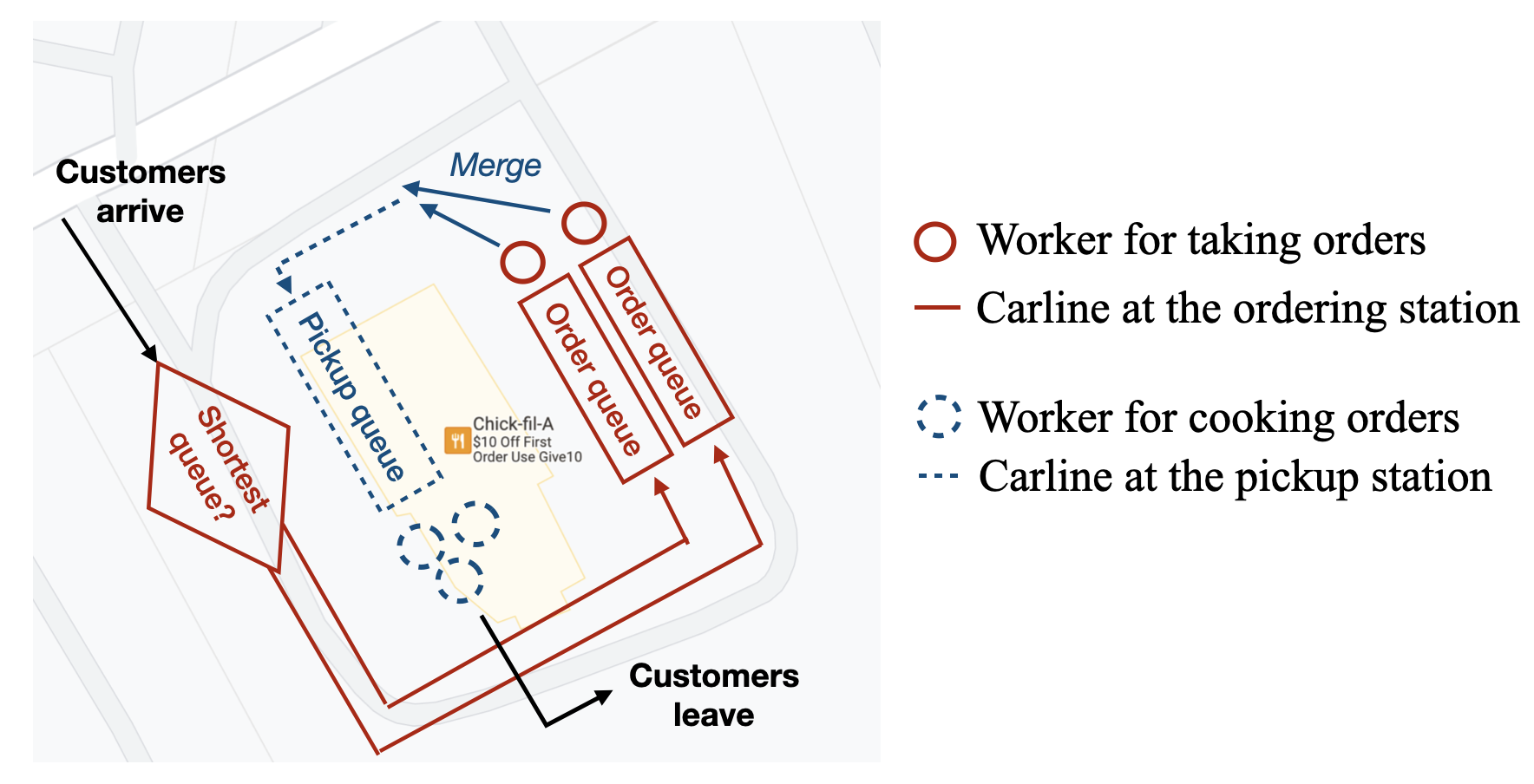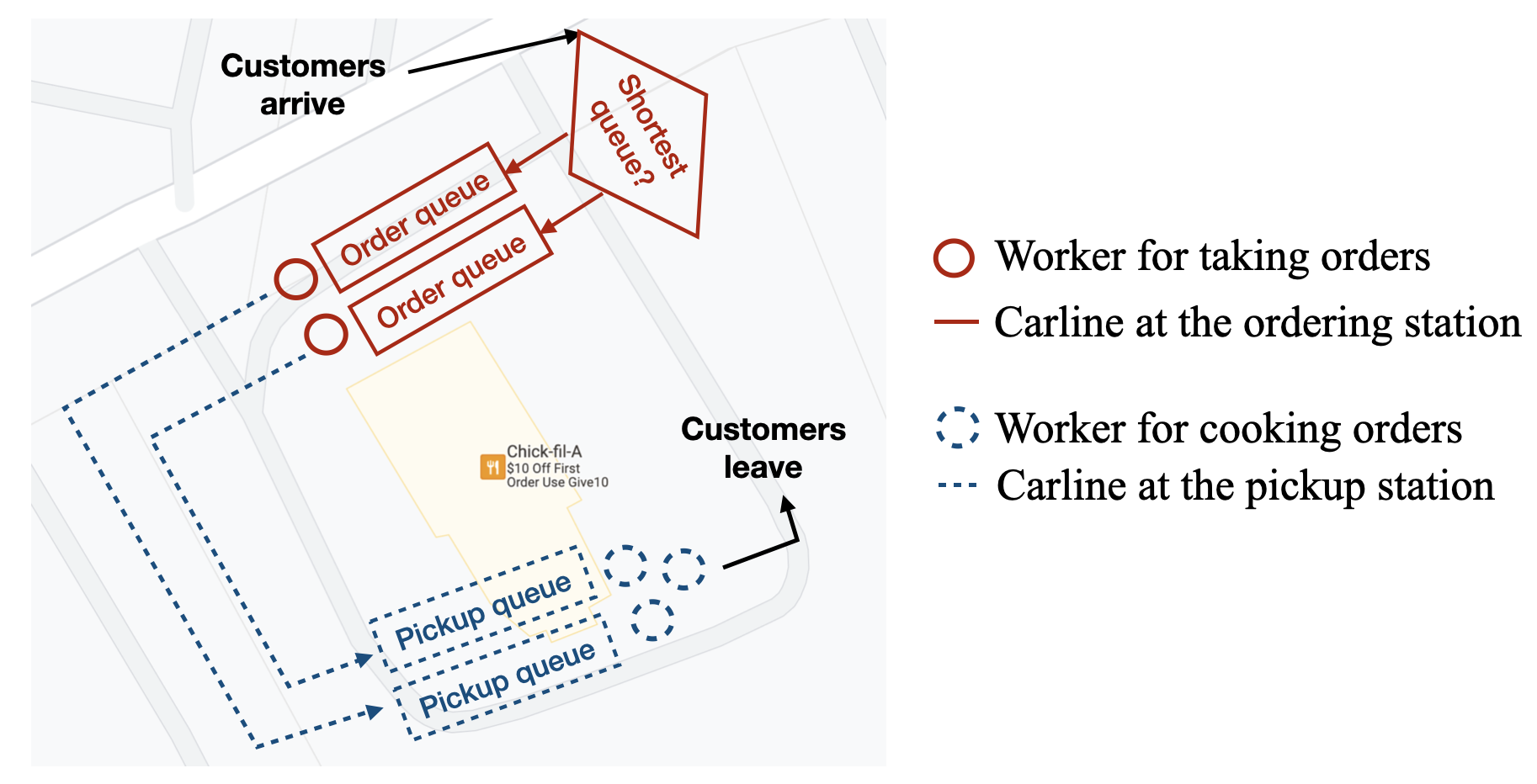Sweeten Chick-fil-A Traffic Jam
Managing Congestion with Math Modeling and Data Analytics
2023-10-12 This is a companion notebook of the paper with the same title.
Chapter 1 Background

Figure 1.1: Image from chick-fil-a.com
We consider the design of the drive-thru lanes of a fast food restaurant, Chick-fil-A, a well-known restaurant chain specializing in chicken sandwiches and related products. We focus on the drive-thru congestion for the following reasons.
- The majority of Chick-fil-A revenue is from drive-thru orders.
- Due to the high demand and limited space, drive-thru lanes are often very congested, resulting in slow services and long car lines.
- Service delays potentially lead to customer abandonment (i.e., lost sales).
- The car line congestion may cause severe traffic problems, including collisions and pedestrian injuries.
- The massive car lines were reported to stretch into streets and parking lots regularly, blocking entrances to neighboring businesses.
Some stores, for example, Chick-fil-A in Santa Barbara, had to rebuild the whole facility after receiving numerous complaints from residents and businesses. However, redesigning the drive-thru is a nontrivial operational decision that must be carefully made.
1.1 Motivating story
This study is based on the renovation of a local Chick-fil-A store at the large Marketplace Mall shopping center in Williamsburg, Virginia. The reference news article (Click here) provides the background information regarding this renovation project. Having long been blamed for the drive-thru queue blocking the main traffic intersection, the Marketplace Chick-fil-A purchased the adjacent lot and built a new facility with a larger capacity.
1.2 Sketches of the Drive-thru
The following Figures show the drive-thru flow before and after the renovation.
1.2.1 Before the renovation
A customer arrives at the Chick-fil-A drive-thru from the main road and decides to join one of the two lanes with a shorter queue to place an order. Solid circles represent Chick-fil-A workers who will take orders from this drive-thru customer. After the order is placed and if there is space in the pickup lane, the vehicle will merge into a single-car lane according to the First-Come-First-Served (FCFS) policy. While in the pickup lane, the customer waits in the car for the order to be prepared by another set of workers, depicted by dashed circles. After picking up the order, the vehicle leaves the facility.

1.2.2 After the renovation
The key difference after the renovation is the design of the pickup lane. Because of the expansion to the adjacent lot, Chick-fil-A can now accommodate two pickup lanes after the ordering station. Moreover, each pickup lane is extended from the corresponding ordering lane; that is, customers cannot choose the pickup lane once they have joined a specific ordering lane.

1.3 Objective
We define the carline of a service station to be the occupied length of the corresponding drive-thru lanes, which measures the spatial stretch of the drive-thru queue. For example, in Figure 1.2(a), the carline at the ordering station is 2 because the longer queue among the two ordering lanes is 2, and the carline at the pickup station is 3. In Figure 1.2(b), the carline at the ordering station is 1 while the carline at the pickup station is 2, the longer queue length among the two pickup lanes.

Figure 1.2: Illustration of carline
The overall objective of this study is as follows.
Model the Chick-fil-A facility before and after the renovation, respectively.
Use Discrete event simulation (DES) to simulate the system and evaluate two congestion-related performance metrics.
Customers’ flow time, defined as the total time a customer spends at Chick-fil-A, measures the impact of congestion on the quality of service. Customers generally prefer a short flow time.
The system carline is defined as the sum of the carlines at the ordering and pickup stations. For example, the system carlines of Figures 1.2(a) and (b) are 5 and 3, respectively. This metric reflects the impact of Chick-fil-A congestion on the neighboring businesses. A large system carline leads to a higher chance of blocking the main road and causing traffic problems.
Decide the best drive-thru design using a grid search of various candidate models.